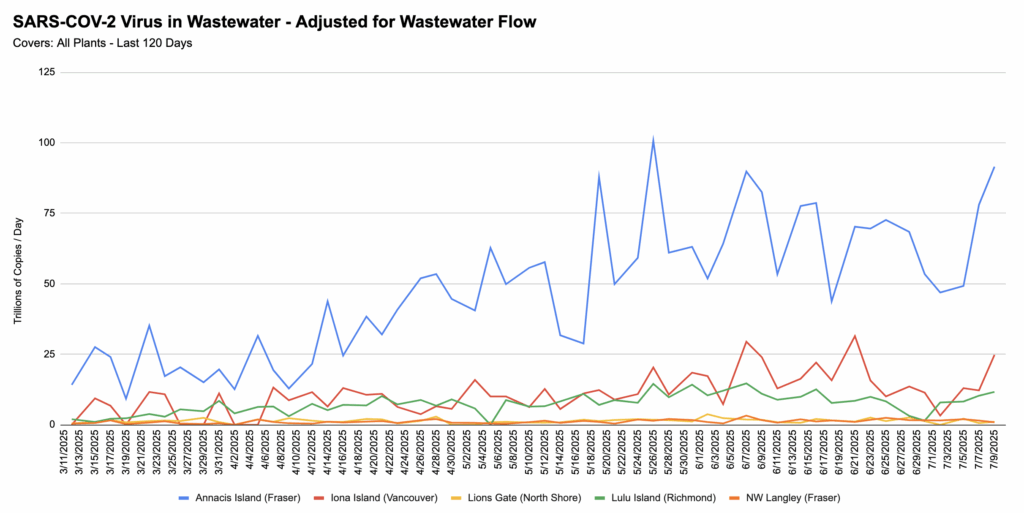COVID-19
Long COVID
This paper from Germany (2025-07-12) found that 21% of masters’ athletes (median age in the high 50s) in their study had Long COVID. The prevalence did not differ by sex, athletic specialties, training load, or prior competition level. Long COVID can happen to healthy, fit people!
Vaccines/Prevention
💊 This paper from Peru (2025-07-11) looked at the relative risks from market vendors who self medicated:
- taking aspirin increased the risk of COVID-19 infection by 134%;
- taking vitamin C decreased the risk of COVID-19 infection by 56%.
Meanwhile, not getting a 💉 COVID-19 booster increased their risk by 238%.
🫀 This paper from Australia (2025-07-16) followed men who had gotten diagnoses of confirmed or probable myocarditis after a COVID-19 mRNA vaccination. They found that 60% still had ongoing symptoms at 3-6 months, and 35% had symptoms at 12-18 months. However, there was low hospitalization and no deaths, and health-related quality of life improved over time.
💉 This paper from Qatar (2025-06-09) reports that the Healthy Vaccinee Effect (HVE) — people who get vaccinated are healthier than people who don’t get vaccinated, so the effectiveness of vaccines can get overstated — is a real problem. They did a very very careful job of matching people vaccinated for COVID-19 with unvaccinated controls, and yet even that wasn’t good enough. They found that people who were vaccinated had a sixty-five percent lower risk of dying from any cause in the six months following the start of the study. That’s too big to be believable.
They found that this was most pronounced in the elderly, which makes sense if you think about it: young people mostly don’t die and are pretty mobile. While there are still a lot of elderly people who are in good shape and mobile (I have two neighbours in their mid-80s who — although they don’t drive any more — are still running their households, going to operas, jetting off to Europe, etc.), there are also a lot who are in bad shape — with low energy, difficulty walking, and multiple medical issues. If the energetic mobile seniors get shots and the tired immobile ones don’t, that will skew the vaccine effectiveness numbers for this group by a lot.
Now, this effect will be a lot smaller in younger people, who are more homogenously in good shape. (So this does NOT mean that “vaccines don’t work”!)
This blog post from someone I respect (2025-06-25) has a longer and more accessible discussion of the problems of HVE. I recommend reading his post.
Treatments
💊 This paper from USA (2025-07-14) reports that for immunocompromised people, taking Paxlovid for 10 or 15 days instead of five days didn’t make a whit of difference.
🍫 Huh. This post (2025-07-16) says that chocolate blunts the metallic taste of Paxlovid. I have no idea if this is true or not, but I want it to be true!
🩸 This paper from USA (2025-07-15) reports that an experimental stem cell treatment of feline infectious peritonitis (FIP) — a coronavirus in cats — worked well. The similarities between FIP and Long COVID make the authors think that this stem cell therapy might be useful against Long COVID.
Mitigation Measures
😷 This paper from Ohio USA (2025-07-15) reported that they found no difference between COVID-19 mortality rates from November 1, 2020, to January 3, 2021 in nursing homes which forbid visiting and those which did not. However, note that there were still infection prevention protocols in place — they didn’t let just any rando off the street come in and start licking residents’ faces. Generally, masks, handwashing, and six foot distancing were in place.
In BC, IIRC, residents could have one or two caretakers who were allowed to enter the facility, and they had to get temperature checks.
Transmission
🐕🦺🐹 This paper (2025-07-17) reports that dogs with COVID-19 infections can transmit it to hamsters.
“Everybody knows” now that school closings were a stupendously bad idea, right? That closing schools didn’t help anything and was really bad for kids, right? Uh, no, actually. This review paper (2025-01-21) looked at a bunch of studies from around the world and found that actually, closing schools did reduce the transmission rate significantly.
(Whether it was worth it is a question that can’t be answered, as it is a choice between two different bad things; everybody will have a different weight on the two different bad things.)
BC Wastewater
💩💧 I don’t know what’s happening with the wastewater. Is it going up? Is it noise? Probably going up a little, but I’m not sure.
From Jeff’s wastewater spreadsheet:

H5N1
Transmission
🪰 This blog post (2025-07-18) goes over some evidence that H5N1 is spread by blowflies. It also discusses in passing some evidence that H5N1 is transmitted by dust in the wind and by rats. Ugh.
🐄 This paper from China(!) (2025-07-01) reports that H5N1 can be passed from an infected cow or calf suckling on the teat of an uninfected cow. They found that cows infected via the nose only had infected cells in the mouth and respiratory, and that cows infected via the teats only had infected cells in the mammary glands. (The abstract didn’t talk about transmission via milking machines, but if teats can only be infected via the teat, there has to be at least one cow per farm which gets infected via the teat.)
Apparently cows sometimes “steal” milk from neighbour cows and/or from themselves. (Who knew?) That could be how the teats get infected absent calves.
Recommended Reading
Last week, I concluded the H5N1 section by saying, “I wish I felt the US federal government was trustworthy at the moment.” This blog post from a prominent virologist (2025-07-05) makes me trust the Trump administration less.
Measles
Transmission
The Government of Canada web page on measles (2025-07-14) says that in the week ending 5 July 2025, there were 120 new cases nationally, including:
- 63 in Alberta;
- 24 in BC;
- 14 in Ontario;
- 14 in Manitoba.
This press release from the province (2025-07-10) says that there was only one active, contagious case as of July 10th.
